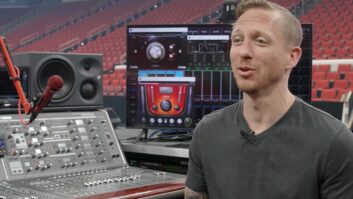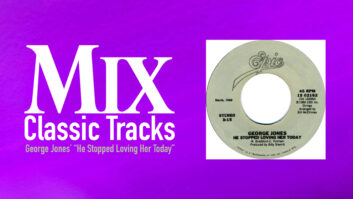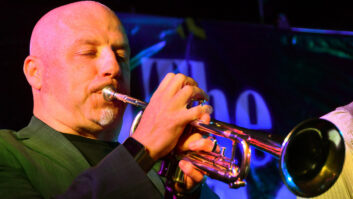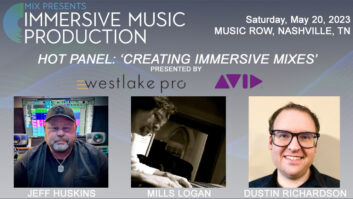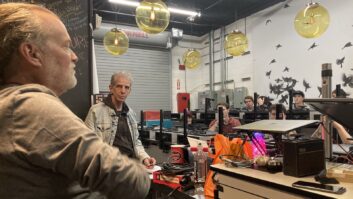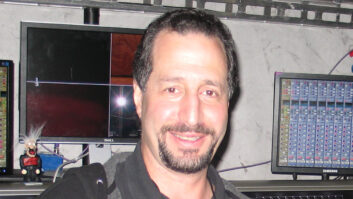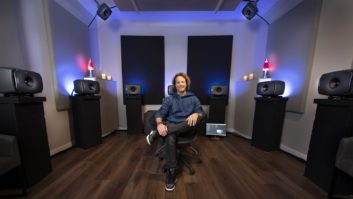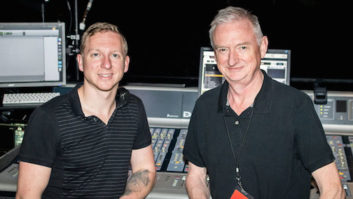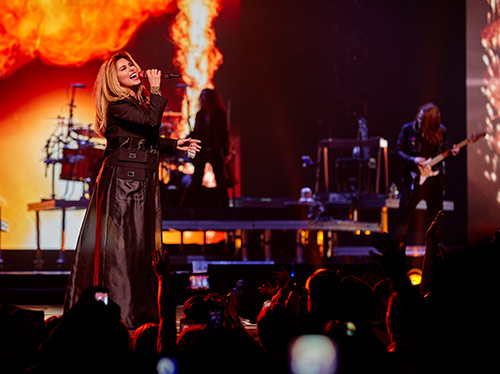
Eventful. That word describes the past year for Shania Twain and company.
Her two-year Las Vegas residency at The Colosseum at Caesar’s Palace ended last December, a couple of months before her Still The One: Live From Vegas album/video set was released; then came the kickoff of her current “Rock This Country” tour.
Twain is calling this arena jaunt through North America, her first tour since 2004, the last of a career that took off like an runaway train in the mid-’90s, zoomed down the tracks for several years, then pulled into the station and stopped.
The arena tour, which rolled Washington’s Verizon Center in late July, was recently extended a second time, through October 27, when it’s slated to wrap at Prospera Place, in Kelowna, B.C. Some of her touring crew worked not only on Still The One, but are no doubt still having nice dreams about the acoustic elegance of The Colosseum. Among them is Twain’s mix engineer, Nigel Green.
Ride Those Parts
Green—whose resume is bulleted by liaisons with Def Leppard, The Cars, Billy Ocean and the Backstreet Boys—has worked extensively with Twain’s former producer, studio legend Mutt Lange, since the ’80s. Though he didn’t “do any live work until late ’90s, with Shania,” he’s “worked with her from the beginning.
“Shania and Mutt made well-crafted records with great hooks,” Green says. “People talk about microphones, compressors and EQs in relation to her sound, but forget about the music. If a part isn’t balanced properly in the mix, it doesn’t matter what mic or compressor you use; when I mix her live shows, I concentrate on riding the parts since, at the end of the day, the music is what people are coming to listen too.”
When preparing for the shows, Green, the band and the sound crew start by “programming the sound of the guitar amps and keyboards first, then fine-tuning them on the mixing console,” he explains. Also on hand is Kenny Sellars, the systems engineer from Nashville-based VER Tour Sound, which is also providing the lighting and the video for the tour.
Sellars, who joined Twain’s sound crew after the Caesars run, mans the P.A. system. On the tour, that’s the Meyer Sound LEO system, complemented by the company’s 1100 LFC (low frequency control element), with the standard complement of Shure and Sennheiser mics, including Shania’s Sennheiser MD5235.

“We bring 44 Leo, 44 Lyon and 24 1100 LFCs, with eight Meyer Mina for front-fills,” Sellars said. “The main hang is 14 LEO over four Lyon W; sides are eight Leo over six LYON; and rear hang is 12 LYON W. We have eight 1100s on the ground and four in the air per side.
Green sends Sellars “a L/R sub and vocal bus,’ he says. “The latter is not typical, because most engineers send a L/R sub and fill. The vocal bus allows me to attenuate her vocal in each box individually.”
Sellars and Green also use a sidechain multiband compressor on the left and right bus. “We compress from 500 to 2k at about 3 dB when Shania’s singing,” Sellars says. “That creates a pocket for her vocal, so it’s not overwhelmed by the music.”
All Digital
Sellars’ keenest focus during the show is watching Shania and attenuating her vocal in any speaker she may wind up in front of.
“I turn her down in the bottom six boxes as she rides the crane—make that her saddle—during ‘Up!’, since the crane takes her within a few feet of the main hang. This allows Nigel to mix without worrying about feedback,” Sellars says. “There’s a similar scenario during ‘Any Man of Mine,’ when she walks down the ramp and into the crowd.”
Sellars and Green create her sound with Twain’s lead guitarist and band leader, Cory Churko; he’s also toured with Kelly Clarkson and Reba McEntire, and worked with the late Mike Shipley, who was Lange’s right-hand man before he became an in-demand mix engineer in L.A. and Nashville.
Churko, who mixed the “Still The One” set with Green, says he’d planned “to build a huge multi-amp guitar rig [he plays Prestige guitars, and Matchless and Bogner amps].” Then his tech, Bryan Jones, “suggested that we at least go with iso cabinets that, upon testing, were a bit of a let down sonically.”
So? “I set up my Kemper profiling amp, modeled my amps and did an A/B test between the amps and the Kemper version. I was blown away. The differences were negligible enough that I decided to use it instead of the real amps. My tech was over the moon, needless to say,” he says, due to quicker setup/tear down, more consistent sound, no tubes or speakers to blow, or mics accidentally getting kicked over before the show.
Programmed in Tandem
Then Churko convinced fellow guitarist Joshua Ray Gooch, steel guitarist Austin Clark and utility guitarist/fiddler Jason Mowery to also use the Kemper amp. At that point, the tour became ampless, in the traditional sense. Churko and Gooch programmed and sculpted all of their sounds in Churko’s studio before rehearsals, “programming levels and effects, from part to part,” Churko says. “That made it quicker for Nigel to refine our tones without loud amps bleeding offstage and muddying the mix.”
But having software-based amplifiers with no cabinets has its downside. “You don’t get the natural interaction and sustain between the guitar pickups and speakers,” he says, “so we feed the Kemper’s aux outs to some Line 6 L3Ts full-range monitors pointed at the ceiling onstage behind us, which help sustain our guitars, but don’t bother Nigel out front.”
Ditto with bassist Derek Frank’s bass rig. “He uses a rack-mounted SansAmp,” Churko said, “so there’s no amp or cabinet on him, either.”
Because all of these amps are MIDI-friendly, the show computer controls all of the patches. This means none of the musicians have to step on any stomp boxes to change patches from part to part, song to song. “We don’t have to run back up the thrust to our pedal boards to change patches before taking solos,” Churko says. “Everything magically changes with MIDI program changes, including wah pedal and volume swells. All we have to do is play.”
In addition, drummer Elijah Wood plays to a click track, “which enables us to create a timecode for the show,” said Green. “Then we can trigger snapshot changes in the FOH console, and MIDI patch changes for the guitars and keyboards. It’s also used for lights and video.”
Teams Work
Also at the FOH, Green sets Twain’s vocal and employs a hardware insert on Pro Tools during “Any Man of Mine,” when she’s circling the arena in her chariot, and cuts her vocal by 7 decibels; it’s automated to cut in and out between lines when she’s not singing, thus avoiding feedback and the screams of fans.
“I try to excite the crowd by riding the musical hooks the fans are used to hearing on the records,” he says. “I ride the faders constantly during the show to accentuate certain points in songs the crowd especially likes, maybe even if a part comes in a little too loud, just to get a reaction. For instance, on ‘Honey, I’m Home,’ Shania yells, ‘Yay’ and points to the crowd, so I turn up the background vocal chants to accommodate. With a guitar solo, I make sure the entry comes in loud to create a statement, as if to say, ‘Here I am.’ If it’s still too loud after the initial entry, I’ll pull it back.”
Green also does “what a lot of people don’t do”—ride the stereo mix bus by three or four decibels, to create excitement and dynamics with the music. “I’m always keeping an eye on the decibel meter. If I don’t, I might overstep a limit.”
The one thing Green learned from making records is that, “There’s no right or wrong way of doing anything, as long as the sound is great.
“It’s all teamwork,” he says. “Great songs, great arrangements, great performers and no clutter. That makes the performance instantly sound better.”
